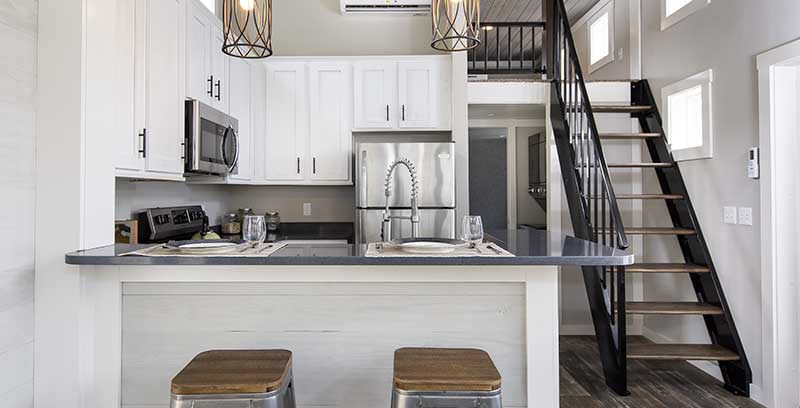
Park Models vs. Tiny Homes
Park Models and Tiny Homes are similar in many aspects, providing their owners with the freedom of a simplified tiny living lifestyle many tiny house enthusiasts desire. Their differences are apparent in price, building code specifications and how they are intended to be used, while all the amenities and interior design can be nearly identical.
Park Models
What sets Park Models apart as a seasonal or vacation living solution, is that they can go with you to new parts of the country as you choose to explore different destinations. Park Models and the term, PMRV (Park Model Recreational Vehicles), can be used interchangeably. PMRVs are floor plans that are 400 square feet or less, built on a metal frame with wheels and are therefore movable. Park Models can be installed as temporary residences where code and zoning permissions allow.
Since Park Models are temporary residences, people often install them at campgrounds and luxury parks as vacation getaways. Permission to install Park Models vary since they require to be hooked up to electricity, sewer and water to operate home style fixtures and appliances. They may be a great solution for a small space on personal property or other locations that allow for RVs.
Lakeside Park Models are certified as complying with ANSI A-119.5-15 standards, a construction standard created by the Recreation Vehicle Industry Association for PMRVs.
Tiny Houses
Tiny “houses” come in all shapes and sizes. There are tiny houses on wheels, Park Model RVs (PMRVs) and tiny modular homes. These small structures have differences in construction and design that technically make them different types of dwellings.
As the tiny home movement continues to grow, confusion about which dwellings can qualify as homes has grown as well.
Much of the stigma around these tiny houses comes from television shows. People see a wide array of small houses on reality television shows. Many of these small, self-constructed dwellings are never permanently placed on land, are not inspected by trained professionals and are of varying quality.
The top concerns that state and local governments express around tiny “houses” are who builds the houses and how each one is built. Government officials express concerns with unregulated construction and the ability of small structures to meet safety and quality expectations.
Tiny homes, if built to code, are typically small modular homes and are designed to be lived in year-round. As small modular homes, tiny homes are built to IRC requirements as well as all applicable state and local building codes. This means they are built to comply with all applicable zoning and building requirements based on where the home will be permanently placed.
Park models are not tiny homes in that they are not designed for or intended for year round living. Instead they are built to the ANSI construction code for park models for seasonal occupancy.
